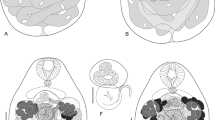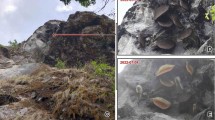Abstract
The systematic relationships among populations of fossorial Aconaemys species (Rodentia, Octodontidae) were assessed using chromosome variation patterns. Cytogenetic data was used since classical taxonomic studies have yielded contradictory results due to the environmentally induced morphological variation observed in these fossorial rodents. The interpopulational karyotypic stability and lack of intrapopulational polymorphism observed in Aconaemys make chromosome data a good predictor of specific differentiation. A distinct karyotype differing in diploid and number of chromosomal arms (FN) was found at each type locality. This kind and degree of karyotypic differentiation together with molecular data indicate that three species of Aconaemys can be recognized: A. sagei (2 n = 54, FN = 104), A. fuscus (2 n = 56, FN = 108), and A. porteri (2 n = 58, FN = 112). Five populations on the western slope of the Andes (Chile: Nahuelbuta, Tolhuaca, Rio Colorado, Pedregoso, Reigolil, and Huerquehue), formerly ascribed as A. fuscus shared the same karyotype of A sagei from the type locality on the eastern slope of the Andes (Argentina: Pampa Hui-Hui). Thus, karyotypic data let us ascribe these disjunct populations to A. sagei. The classical morpho-species in Aconaemys, altered into the biological species based on chromosomal and molecular differentiation, indicates that all three species occur in Chile. After this survey, the range of A sagei is extended to the northwestern slope of the Andes by more than 300 km.
Zusammenfassung
Die systematischen Beziehungen von Populationen unterirdisch Lebender Aconaemys-Arter (Rodentia, Octodontidae) wurden an Hand chromosomaler Vaniationsmuster untersucht. Die zytoge-netischen Techniken wurden eingesetzt, da klassische taxonomische Studien bisher aufgrund umweltbedingter morphologischer Variation widersprüchliche Ergebnisse geliefert hatten. Die karyotypische Stabilität und das Fehlen eines Polymorphismus innerhalb der Populationen von Aconaemys sprechen für eine diffenentialdiagnostische Brauchbarkeit der Chromosomenvariation für die Unterscheidung von Arten. Für jeden lokalen Typus ergaben sich deutlich unterschiedliche Karyotypen sowohl hinsichtlich der diploiden Chromosomenzahl als auch hinsichtlich der Zahl der Chromosomenarme (FN). Nach der karyotypischen und molekularen Differenzierung ergeben sich drei Arten für die Gattung Aconaemys: A. sagei (2 n = 54, FN = 104), A. fuscus (2 n = 56, FN = 108) und A. porteni (2 n = 58, FN = 112). Fünf Populationen am westlichen Hang der Anden (Chile: Nahuelbuta, Tolhuaca, Rio Colorado, Pedregoso, ReigoLiL und Huerquehue), die bisher A. fuscus zugeschrieben wurden, zeigten denselben Karyotyp wie A. sagei von der Typus-Lokalität am östlichen Hang der Anden (Argentinien: Pampa Hui-Hui). Die karyotypischen Daten erlauben somit eine Zuordnung der disjunkten Populationen zu A. sagei. Die klassischen Morphospezies von Aconaemys, biologisch umrissen durch chromosomale und molekulare Daten, kommen alle drei in Chile vor. Unsere Daten weisen daraufhin, daß das Verbreitungsgebiet von A. sagei über mehr als 300 km bis zum nordwestlichen Hang der Anden erweitert werden muß.
Similar content being viewed by others
References
Baker, R. I.; Haiduk, M. W.; Robbins, L. W.; Cadena, A.; Koop, B. F. (1982): Chromosomal studies of South American bats and their systematic implications. In: Mammalian Biology in South America. Ed. by M. A. Mares and H. H. Genoways. Pimatuning Laboratory of Ecology University of Pittsburgh 6, 303–327.
Begall, S.; Gallardo, M. H. (2000): Spalacopus cyanus (Rodentia: Octodontidae): an extremist in tunnel constructing and food storing among subterranean mammals. J. Zool. (London) 251, 53–60.
Clapperton, C. M. (1993): Nature of environmental changes in South America at the last glacial maximum. Paleogeogr., Paleoclimatol., Paleoecol. 101, 189–208.
Clapperton, C. M. (1994): The Quaternary glaciation of Chile: a review. Rev. Chilena Hist. Nat. 67, 369–383.
Contreras, L. C.; Torres-Mura, J. C.; Yáñez, J. L. (1987): Biogeography of octodontid rodents: an ecoevolutionary hypothesis. Fieldiana, Zool. 39, 401–411.
Gallardo, M. H. (1992): Karyotypic evolution in octodontid rodents based on C-band analysis. J. Mammalogy 73, 89–98.
Gallardo, M. H. (1997): A saltation model of karyotypic evolution in the Octodontoidea (Mammalia, Rodentia). In: Chromosomes Today. Vol. 12. Ed. by N. Henriques-Gil, J. S. Parker, and M. J. Puertas. London: Chapman and Hall. Pp. 347–365.
Gallardo, M. H.; Reise, D. (1992): Systematics of Aconaemys (Rodentia, Octodontidae). J. Mammalogy 73, 779–788.
Gallardo, M. H.; Kirsch, J. W. A. (2001): Molecular relationships among Octodontidae (Mammalia: Rodentia: Caviomorpha). J. Mammalian Evol. 8, 73–89.
Gallardo, M. H.; Bickham, J. W.; Honeycott, R. L.; Ojeda, R. A.; Köhler, N (1999): Discovery of tetraploidy in a mammal. Nature 401, 341.
Greer, J. K. (1965): Mammals of Malleco Province, Chile. Publications of the Museum, Michigan State Univ. Biol. Ser. 3, 49–152.
Haffer, J. (1979): Quaternary biogeography of tropical lowland South America. In: The South American Herpetofauna: its Origin, Evolution, and Dispersal. Ed. by W. W. Duellman. Lawrence: University of Kansas Press. Pp. 107–140.
Heusser, C. I.; Flint, R. F. (1977): Quatennary glaciations and environments of northern Isla Chiloé, Chile. Geology 5, 305–308.
King, M. (1993): Species Evolution. The Role of Chromosome Change. New York: Cambridge University Press.
Köhler, N.; Gallardo, M. H.; Contreras, L. C.; Torres-Mura, J. C. (2000): Allozymic variation and systematic relationships of the Octodontidae and allied taxa. (Mammalia, Rodentia). J. Zool. (London) 252, 243–250.
Lande, R. (1979): Effective deme size during long-term evolution estimated from rates of chromosomal rearrangements. Evolution 33, 234–251.
Lande, R. (1985): The fixation of chromosome rearrangements in a subdivided population with local extinction and colonization. Heredity 54, 323–332.
Mares, M. A.; Braun, J. K.; Bárquez, R. B.; Díaz, M. M. (2000): Two new genera and species of halophytic desert mammals from isolated salt flats in Argentina. Ocass. Papers Mus. Texas Tech. Univ. 203, 1–27.
Markgraf, V.; Mcglone, M.; Hope, G. (1995): Neogene paleoenvironmental and paleoclimatic change in southern temperate ecosystems - a southern perspective. Trends Ecol. Evol. 10, 143–147.
Mercer, J. H. (1983): Cenozoic glaciations in the southern hemisphere. Annu. Rev. Earth Planet Sci. 11, 99–132.
Moritz, C.; Patton, J. L.; Schneider, C. I.; Smith, T. B. (2000): Diversification of rainforest faunas: an integrated molecular approach. Annu. Rev. Ecol. Syst. 31, 533–563.
Nachman, N. W.; Myers, P. (1989): Exceptional chromosomal mutations in a rodent population are not strongly underdominant. Proc. Nat. Acad. Sciences, USA 86, 6666–6670.
Osgood, W. H. (1943): The mammals of Chile. Field Museum of Natural History, Zool. Series 30, 1–268.
Paskoff, R. P. (1977): Quaternary of Chile: the state of research. Quat. Res. 8, 2–31.
Patton, J. L. (1967): Chromosome studies of certain pocket mice, genus Perognathus (Rodentia, Heteromyidae). J. Mammalogy 48, 27–37.
Patton, J. L. (1970): Chromosome studies of pocket gophers, genus Thomomys. II. Variation in T. bottae in the American Southwest. Cytogenetics 9, 139–151.
Patton, J. L. (1973): An analysis of natural hybridization between the pocket gophers, Thomomys bottae and Thomomys umbrinus. J. Mammalogy 54, 561–584.
Patton, L.; Brylski, P. V. (1987): Pocket gophers in alfalfa fields: causes and consequences of habitat-related body size variations. Am. Nat. 130, 493–506.
Pearson, O. P. (1984): Taxonomy and natural history of some fossorial rodents of Patagonia, southern Argentina. J. Zool. (London) 202, 225–237.
Pearson, O. P. (1995): Annotated keys for identifying small mammals living in or near Nahuel Huapi National Park or Lanín National Park, southern Argentina. Mastozool. Neotropical 2, 99–148.
Pine, R. H.; Miller, S. D.; Schamberguer, M. L. (1979): Contributions to the mammalogy of Chile. Mammalia 43, 339–376.
Reig, O. A.; Bush, C.; Ortell, M. O.; Contreras, J. R. (1990): An overview of evoultion, systematics, population biology, cytogenetic, molecular biology and speciation in Ctenomys. In: Evolution of Subterranean Mammals at the Organismal and Molecular Levels. Ed. by E. Nevo and O. A. Reig. New York: Alan R. Liss. Pp. 71–96.
Smith, M. E.; Patton, J. L. (1993): The diversification of South American murid rodents: evidence from mitochondnial DNA sequence data for the Akodontine tribe. Biol. J. Linn. Soc. 50, 149–177.
Thaeler, C. S. (1968): Karyotypes of sixteen populations of the Thomomys talpoides complex of pocket gophers (Rodentia, Geomyidae). Chromosoma 25, 172–183.
Thaeler, C. S. (1980): Chromosome numbers and systematic relations in the genus Thomomys (Rodentia, Geomyidae). J. Mammalogy 61, 414–422.
Venegas, W. (1974): Estudio citogenético en Aco-naemys fuscus fuscus Waterhouse (Rodentia, Octodontidae). Bol. Soc. Biol. Conception 47, 207–214.
Vrba, E. (1992): Mammals as a key to evolutionary theory. J. Mammalogy 73, 1–28.
Wahrman, I.; Goitein, R.; Nevo, E. (1969): Geographic variation of chromosome forms in Spalax, a subterranean mammal of restricted mobility. In: Comparative Mammalian Cytogenetics. Ed. by K. Benirschke. New York: Springer Verlag. Pp. 30–48.
Author information
Authors and Affiliations
Corresponding author
Rights and permissions
About this article
Cite this article
Gallardo, M.H., Mondaca, F. The systematics of Aconaemys (Rodentia, Octodontidae) and the distribution of A. sagei in Chile. Mamm Biol 67, 105–112 (2002). https://doi.org/10.1078/1616-5047-00015
Received:
Accepted:
Published:
Issue Date:
DOI: https://doi.org/10.1078/1616-5047-00015




